World's largest palace
This article has multiple issues. Please help or discuss these issues on the talk page. (Learn how and when to remove these template messages)
|
The title of the "world's largest palace" is both difficult to award and controversial, as different countries use different standards to claim that their palace is the largest in the world.
The title of "world's largest palace by area enclosed within the palace's fortified walls" is held by China's Forbidden City complex in Beijing, which covers an area of 728,000 square metres (180 acres). The 980 buildings of the Forbidden City have a combined floor space of 1,614,600 square feet (150,001 m2) and contain 9,999 rooms (the ancient Chinese believed the god Yù Huáng had 10,000 rooms in his palace; so they constructed an earthly palace to have 9,999 and a half rooms, slightly fewer than in the divine palace, out of respect).
The world's largest palace by both floor space and volume is the Palace of the Parliament in Bucharest, Romania, which was built by communist dictator Nicolae Ceaușescu in 1986.[1] It has a floor space of 330,000 m2 and a volume of 2,550,000 m3. It is also the most expensive administrative building and heaviest building.[1]
The "world's largest royal palace by floor space" is the Royal Palace of Madrid in Spain, with 135,000 square metres (1,450,000 sq ft) of floor space and containing 3,418 rooms.[2]
The title of "world's largest royal domain," as measured by the total area of the property, goes to Balmoral Castle in Scotland. The castle's grounds cover 20,000 hectares (50,000 acres), or 200 square kilometres (77 sq mi)
The Potala Palace in Lhasa, China, with 1000 rooms on 13 levels, and over 130,000 square metres (1,400,000 sq ft) of floor space,[3] is one of the largest palaces in the world by floor area. It was the winter residence of the Dalai Lama until 1959. (Many sources[4] give the area as 360,000 square metres (3,900,000 sq ft).)
In the castle category, Prague and Malbork Castles claim to be world's largest. However, despite its singular name, Prague Castle is not a single building. Like the Forbidden City, it comprises a number of palaces, temples, and halls (constructed over several centuries) that share a common defensive wall. Altogether, the complex covers 18 acres (7.3 ha), leading to the self-appointed title of "largest coherent castle complex in the world."[5]
Faux palaces
While many buildings carry the title of "palace," they either are no longer, or were never intended to be, used as a royal residence, a sovereign residence or a bishop residence.
Romania's Palace of the Parliament contains 3,552,120 square feet (330,003 m2) of floorspace,[6] it was never a royal residence, as Romania's last monarch was forced to abdicate in 1947, but it was the palace intended to be used by the sovereign Nicolae Ceausescu, Romania's supreme ruler and dictator.
Britain's Palace of Westminster was built in the Middle Ages as a royal residence. It served as the principal residence of the monarch until 1522, when Henry VIII moved his court to the newly acquired Palace of Whitehall.[7] Since that time, the palace at Westminster has been used by the House of Lords, the House of Commons and various courts. The majority of the medieval palace was destroyed by fire in 1834, with construction of the current building starting in 1840. The palace which now stands on the site was designed specifically for parliamentary use, however it is the property of the monarch in right of the Crown and retains its status as a royal residence. Very little of the medieval palace survived, but the most significant is Westminster Hall, built in 1097 during the reign of William II.
Converted palaces
Several palaces are former royal residences that reached their current grand sizes after they ceased being used as royal residences, and were converted to some other purpose.
The best example of such subsequent expansion is the Louvre Palace. As a royal residence, it was much smaller than the current Louvre Museum. The Louvre Palace was abandoned as a royal residence in 1682, when Louis XIV moved his court to the Palace of Versailles. The Louvre Palace was relegated to the role of displaying royal collections and hosting administrative services, and over the centuries, it went through several renovations, expansions and additions, including a significant one as an imperial project during the Second French Empire in the 19th century. It reached its current size of 2,260,421 square feet (210,000 m2) only in 1988, as the modern Louvre Museum.
Russia's Winter Palace and its annexes were not expanded after the Russian Revolution, but the State Hermitage Museum also occupies other buildings, which add to the size of the museum but not to the palace. The Winter Palace contained 645,835 square feet (60,000 m2) of floorspace as a royal residence. However, the modern Hermitage Museum complex, centered on the Winter Palace, contains 1,978,622 square feet (183,820 m2) of floorspace.[8] That includes the Small and the Old Hermitage buildings that were annexes to the main palace, which were used by the Imperial Court and are part of the palace complex. The same is true of the New Hermitage, which has been used as a museum for the Imperial collections ever since it was built. All three Hermitages and the Hermitage Theatre can thus be considered both independent buildings and wings of the Winter Palace.
Despite a size that overshadows most other great palaces in Europe, the Winter Palace does not contain as much floorspace since most of the state apartments in the northern and the eastern wings are two floors high.
Uninhabited palaces
With 1,453,122 square feet (134,999 m2) of floorspace,[9] the Royal Palace of Madrid is often considered the largest functioning palace in Europe [2], as it is still used for state functions. Although Spanish monarchs once occupied it, the current King of Spain does not, instead living at the much smaller Palace of Zarzuela.
Although notably smaller than several other palaces throughout the world, with only 658,858 square feet (61,210 m2) of floorspace, the Royal Palace of Stockholm also claims to be "the largest palace in the world still used for its original purpose." Yet, like the Royal Palace of Madrid, it is not currently occupied, with Swedish monarchs instead occupying Drottningholm Palace.
Guinness World Record
While numerous claimants under the various measurements can be recognized, to be considered for the Guinness World Record the palace must have once been intended for use as a royal residence. This is controversial as the definition of a palace is the official residence of a sovereign, chief of state (as a monarch or a president), archbishop, bishop.[10] Furthermore, only the combined area of all floors in the palace (a measurement commonly known as floorspace) is considered.
According to the Guinness World Records, Forbidden City holds the "largest palace in the world".[11] The Istana Nurul Iman, with 2,152,782 square feet (200,000 m2) of floorspace,[12] holds the title as the "world's largest residential palace" held in Brunei.[13]
Largest former palace complexes

In ancient times palace buildings could be as large or even larger than existing palace buildings. One example is the palace of Knossos on the Greek island of Crete. The palace, which started construction in 2000 BC, reached its largest size in 1500 BC with a size of 20,000 m2 (215,278.208 ft²) and 1,300 rooms.[14]
The Malkata palace complex was built by the Pharaoh Amenhotep III in the 14th Century BC. The size of the palace complex is unknown, but it contained a T-shaped artificial lake covering an area of at least 2 km2 (3.6 km2 according to some estimates).[15] The size of the main palace itself was 30,000 m2.
The Roman emperor Hadrian's Villa at Tivoli, Italy was a complex of over 30 buildings constructed between 118 and the 130s AD, covering an area of at least 250 acres (1,000,000 square metres (11,000,000 sq ft)) of which much is still unexcavated. The villa was the greatest Roman example of an Alexandrian garden, recreating a sacred landscape. The complex included palaces, several thermae, theatre, temples, libraries, state rooms, and quarters for courtiers, praetorians, and slaves.[16][17][18]
When Roman emperor Nero's "Golden House" (Domus Aurea) was built after the great fire of AD 64, the buildings covered up to 300 acres (1,214,056 square metres (13,067,990 sq ft)). The main villa of the complex had more than 300 rooms.[19][20]
In 200 BC, the Weiyang Palace was built at the request of the Emperor Gaozu of Han, under the supervision of his prime minister, Xiao He. The palace survived until the Tang dynasty, when it was burnt down by marauding invaders en route to the Tang capital, Chang'an. It was the largest palace complex ever built on Earth,[21] covering 4.8 square kilometres (1.9 sq mi), which is 6.7 times the size of the current Forbidden City, or 11 times the size of the Vatican City.
The Daming Palace was the imperial palace complex of the Tang dynasty in Chang'an. It served as the imperial residence of the Tang emperors for more than 220 years. In 634, the Emperor Taizong of Tang launched the construction of the Daming Palace at Longshou Plateau. He ordered the construction of the summer palace for his retired father, the Emperor Gaozu of Tang, as an act of filial piety. However, the Emperor Gaozu grew ill and never witnessed the palace's completion before his death in 635, and construction halted thereafter. Wu Zetian commissioned the court architect Yan Liben to design the palace in 660, and construction commenced once again in 662. In 663, the construction of the palace was completed under the reign of the Emperor Gaozong of Tang. The Emperor Gaozong had launched the extension of the palace with the construction of the Hanyuan Hall in 662, which was finished in 663. On 5 June 663, the Tang imperial family began to relocate from the Taiji Palace into the yet to be completed Daming Palace, which became the new seat of the imperial court and political center of the empire. The area of the palace complex was 3.11 km2.
Comparison of world's largest palaces
| Rank | Name | Country | Place | Floor area | Notes | Source | Image |
|---|---|---|---|---|---|---|---|
| 1 | Palace of the Parliament | Bucharest | 330,000 square metres (3,552,090 sq ft) | The Palace of the Parliament is the world's largest administrative building (for civilian use; The Pentagon in the United States is larger, at 620,000 m2). It measures 270 m by 240 m, 86 m high, and 92 m under ground. It has 1,100 rooms and is 12 stories tall, with additional 8 underground levels.[22] The palace was intended to be used by Nicolae Ceausescu, Romania's supreme leader and dictator. A colossal parliament building known for its ornate interior, it is now housing the Senate and the Chamber of Deputies, three museums and an international conference center. The National Museum of Contemporary Art, the Museum of Totalitarianism and Socialist Realism and the Museum of the Palace are hosted inside the palace.[23] | [22][23] |  | |
| 2 | Hofburg Palace | Vienna | 240,000 square metres (2,583,339 sq ft) | Former imperial palace in the centre of Vienna. Part of the palace forms the official residence and workplace of the President of Austria. Built in the 13th century and expanded in the centuries since, the palace has housed some of the most powerful people in European and Austrian history, including monarchs of the Habsburg dynasty, rulers of the Austro-Hungarian Empire. It was the principal imperial winter residence. The palace has 2600 rooms. | [24][25] |  | |
| 3 | Louvre Palace | Paris | 210,000 square metres (2,260,421 sq ft) | Royal residence of the kings of France for 300 years. Later converted into an art museum. | [26] |  | |
| 4 | Ak Saray Presidential Complex | Ankara | 200,020 square metres (2,152,997 sq ft) | The official presidential palace of the Republic of Turkey since 2014. Replacing the Çankaya Mansion. | [27][28] | 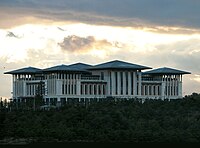 | |
| 5 | Istana Nurul Iman | Bandar Seri Begawan | 200,000 square metres (2,152,782 sq ft) | Official residence of the Sultan of Brunei. The largest functioning royal palace in the world. | [12] |  | |
| 6 | Apostolic Palace | Vatican City | 162,000 square metres (1,743,753 sq ft) | Official residence of the Pope of the Roman Catholic Church. Current Papal Palace and Vatican Museums in Rome. | [29] |  | |
| 7 | Forbidden City | Beijing | 150,000 square metres (1,614,587 sq ft) | With an enclosed area of 720,000 square metres (180 acres), it is the world's largest palace complex. Originally the official residence of the Emperor of China. Currently operates the Palace Museum. | [30] | 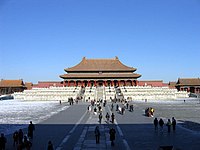 | |
| 8 | Malbork Castle | Malbork | 143,000 square metres (1,539,239 sq ft) | Located in Poland, Malbork Castle is the largest castle in the world. The castle was founded in 1274 by the Teutonic Knights who used it as their headquarters to help defeat Polish enemies and rule their own northern Baltic territories. The castle was expanded several time to host the growing number of Knights until their retreat to Königsberg in 1466. | [31] |  | |
| 9 | Royal Palace of Madrid | Madrid | 135,000 square metres (1,453,128 sq ft) | The largest functioning palace in Europe. Serves as the official residence of the Spanish royal family. | [9] |  | |
| 10 | Quirinal Palace | Rome | 110,500 square metres (1,189,412 sq ft) | Ancient Pope's and King of Italy's palace and current presidential palace of the President of the Italian Republic. Originally intended to be the official residence of Napoleon Bonaparte. The presidential residence also has a garden with an area of 430,556 square feet (40,000.0 m2). | [32][33] |  | |
| 11 | Abdeen Palace | Cairo | 108,000 square metres (1,162,502 sq ft) |
The construction of the palace begin in 1863 and it was officially opened in 1874. In 1921 Sultan Fuad I added the gardens. The total size of the palace complex is 192,000 square metres (2,070,000 sq ft). Serves as the official workplace of the President of Egypt. |
 | ||
| 12 | Falaknuma Palace | Hyderabad | 93,971 square metres (1,011,495 sq ft) | Built in the year 1889 in Hyderabad, India it was owned by the Nizams, the rulers of the princely state of Hyderabad, until 1950. Currently operated as a luxury hotel by Taj Hotels. |  | ||
| 13 | Istana Negara | Kuala Lumpur | 90,082 square metres (969,635 sq ft) | Istana Negara is the official residence of the Yang di-Pertuan Agong, the monarch of Malaysia. It is located along Jalan Tuanku Abdul Halim in Segambut, northwestern Kuala Lumpur. The palace opened in 2011 and replaced the old Istana Negara which was located at a different compound in central Kuala Lumpur. The palace complex has an area of 97.65 hectares, 22 domes, and is split into three main portions: the Formal Component, Royal Component and Administration Component. | [34][35] |  | |
| 14 | Palace of Venaria | Venaria Reale | 80,000 square metres (861,113 sq ft) | The Palace was designed and built from 1675 by Amedeo di Castellamonte, it is one of the Residences of the Royal House of Savoy. |  | ||
| 15 | Buckingham Palace | London | 77,000 square metres (828,821 sq ft) | A royal residence since George III bought Buckingham House in 1761 for his wife Queen Charlotte and has been the official London residence of the British sovereign since Queen Victoria took up residence in July 1837. The palace contains 775 rooms and has a garden 40 acres (16 ha) in size. | [36][37] |  | |
| 16 | Çırağan Palace | Istanbul | 76,000 square metres (818,057 sq ft) | The palace, built by Sultan Abdulaziz, was designed by the Armenian palace architect Nigoğayos Balyan and constructed by his sons Sarkis and Hagop Balyan between 1863 and 1867, during a period in which all Ottoman sultans built their own palaces rather than using those of their ancestors; Çırağan Palace is the last example of this tradition. |  | ||
| 17 | Prague Castle | Prague | 70,000 square metres (753,474 sq ft) | Seat of power for kings of Bohemia, Holy Roman emperors, presidents of Czechoslovakia and currently presidents of the Czech Republic. Dating back to the 9th century and at about 570 metres (1,870 ft) in length and an average of about 130 metres (430 ft) wide, the Guinness Book of Records lists Prague Castle as the largest ancient castle in the world. | [38] |  | |
| 18 | Topkapi Palace | Istanbul | 70,000 square metres (753,474 sq ft) | Primary residence of the Ottoman Dynasty for approximately 400 years between the Ottoman conquest of Constantinople and the dissolution of the Ottoman Empire. The entire palace complex including grounds occupies 700,000 square metres (7,500,000 sq ft). | [39][40] |  | |
| 19 | Palace of Versailles | Versailles | 63,154 square metres (679,784 sq ft) | World's largest royal domain with 87,728,720 square feet (8,150,265 m2) or 2,014 acres of palace grounds. Constructed by King Louis XIV and used as the official seat of the King of France. Was the site of the ratification of the Treaty of Paris, the Proclamation of the German Empire, and the signing of the Treaty of Versailles. Currently used as a secondary chamber by the French Senate. | [41] |  | |
| 20 | Royal Palace of Stockholm | Stockholm | 61,210 square metres (658,859 sq ft) | Claims to be world's largest palace still used for its original purpose, despite its smaller floor area. Used as the official residence of the Swedish sovereign. |  | ||
| 21 | Royal Palace of Caserta | Caserta | 47,000 square metres (505,904 sq ft) | Former royal residence in Caserta, southern Italy, constructed by the House of Bourbon-Two Sicilies as their main residence as kings of Naples. The palace has a rectangular plan, measuring 247 × 184 m, and the four sides are connected by two orthogonal arms, forming four inner courts. The size of the building is 47000 square meters including four courtyards of 3800 square meters each. Without the courtyards, the size of the building is 31,800 square meters. Even without the surface area of the internal courtyards Caserta is the largest royal palace resulting from a single original project in the world in terms of volume, with more than 1 million m³ (35 million cu ft). | [42] |  | |
| 22 | Winter Palace | Saint Petersburg | 60,000 square metres (645,835 sq ft) | Used as the official residence and imperial palace of the Emperor of Russia between 1732 and 1917. Briefly served as the seat of the Provisional Government. Currently part of 1,978,622 square feet (183,820 m2) Hermitage Museum. | [8] | 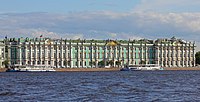 | |
| 23 | Mannheim Palace | Mannheim | 60,000 square metres (645,835 sq ft) | Mannheimer Residenz is the main palace of the Prince-electors of the Electorate of the Palatinate of the House of Wittelsbach. The 6 ha (60,000 m2) castle is one of Europe's largest palaces and the second largest baroque palace (after Versailles). |  | ||
| 24 | Windsor Castle | Windsor | 54,835 square metres (590,239 sq ft) | Castle which dates back to around 1070 and has 5455 acres of royal parkland. Many famous people associated with British Royalty are buried in St Georges Chapel at Windsor Castle including Henry VIII.
It is also the World's largest and oldest inhabited castle. |
[31] | 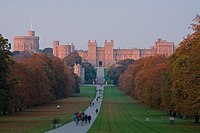 | |
| 25 | Christiansborg Palace | Copenhagen | 51,660 square metres (556,064 sq ft) | The seat of the Danish Parliament, the Prime Minister's Office and the Supreme Court. Also, several parts of the palace are used by the monarchy, including the Royal Reception Rooms, the Palace Chapel and the Royal Stables. Christiansborg Palace has a more than 800 year-long history as the state's centre of power as royal palace and parliament.[43][44] | [45] |  | |
| 26 | Hampton Court Palace | Richmond upon Thames | 47,330 square metres (509,456 sq ft) | Palace dating back to 1515 containing 1000 rooms and grounds comprising 60 acres of formal gardens and 750 acres of royal parkland. | [46][47] |  | |
| 27 | Berlin Palace | Berlin | 45,000 square metres (484,376 sq ft) | The former residence of the Hohenzollern dynasty, the rulers of the Kingdom of Prussia, and later the German Empire, was severely damaged in World War II. It was completely demolished in 1950 and 1951, although large parts of the palace were still standing. In its place, the German Democratic Republic built the Palace of the Republic. The Palace of the Republic was demolished between 2006 and 2008 due to asbestos contamination and the former Berlin Palace was reconstructed as the Humboldt Forum, a large museum, between 2013 and 2021. |  | ||
| 28 | Dolmabahçe Palace | Istanbul | 45,000 square metres (484,376 sq ft) | Located in the Beşiktaş district of Istanbul, Turkey, on the European coast of the Strait of Istanbul, served as the main administrative center of the Ottoman Empire from 1856 to 1887 and from 1909 to 1922. |  | ||
| 29 | Grand Serail | Beirut | 39,970 square metres (430,233 sq ft) | Headquarters of the Prime Minister of Lebanon. Previously served as an Ottoman Army garrison, the headquarters of the French Governor of Syria and Lebanon, and the President of Lebanon's residence. |  | ||
| 30 | Mafra National Palace | Mafra | 39,948 square metres (429,997 sq ft) | The Mafra National Palace is a monumental Baroque and Italianized Neoclassical palace-monastery located in Mafra, Portugal. |  | ||
| 31 | Het Loo Palace | Appeldoorn | 36,042 square metres (387,953 sq ft) | Is a Dutch Baroque Palace built between 1684 and 1686 for stadtholder-king William III and Mary II of England. | 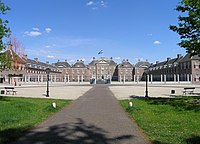 | ||
| 32 | Royal Palace of Brussels | Brussels | 33,027 square metres (355,500 sq ft) | Palace in Brussels dating back to 1783. The Royal Palace of Brussels is the official palace of the Sovereign of Belgium, However it is not used as a royal residence, as the king and his family live in the Royal Castle of Laeken on the outskirts of Brussels. | [48] |  | |
| 33 | Palazzo Pitti | Florence | 32,000 square metres (344,445 sq ft) | Renaissance, palace, the core of the present palazzo dates from 1458. The palace was bought by the Medici family in 1549 and became the chief residence of the ruling families of the Grand Duchy of Tuscany. In the late 18th century, the palazzo was used as a power base by Napoleon, and later served for a brief period as the principal royal palace of the newly united Italy. The complex also includes the Boboli Gardens (320,000 square metres (3,400,000 sq ft)). | [49] | 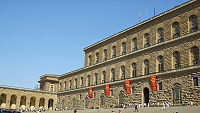 | |
| 34 | Frederiksborg Palace | Hillerød | 31,290 square metres (336,803 sq ft) | It was built as a royal residence for King Christian IV and is now a museum of national history. The current edifice replaced a previous castle erected by Frederick II and is the largest Renaissance palace in Scandinavia. The entire palace complex including grounds occupies 95 hectares (950,000 m2).[50] | [51] |  | |
| 35 | Schoenbrunn Palace | Vienna | 31,056 square metres (334,284 sq ft) | Baroque Palace dating back to the 1740s. The grounds of Schönbrunn, a World Heritage Site, cover 160 hectares. Served as the summer palace of the Habsburg monarchs. | [52][53] | ||
| 36 | El Escorial | San Lorenzo de El Escorial | 30,658 square metres (330,000 sq ft) | Monastery of the Order of Saint Augustine, Royal Palace and Royal Pantheon. | [54] |  | |
| 37 | Kronborg | Helsingør | 28,724 square metres (309,183 sq ft) | Immortalized as Elsinore in William Shakespeare's play Hamlet, Kronborg is one of the most important Renaissance castles in Northern Europe and has been added to UNESCO's World Heritage Sites list (2000).[55][56] | [57] |  | |
| 38 | Amalienborg | Copenhagen | 26,500 square metres (285,244 sq ft) | Home of the Danish royal family, It consists of four identical classical palace façades with rococo interiors around an octagonal courtyard, in the centre of the square is a monumental equestrian statue of Amalienborg's founder, King Frederick V.[58] | [59] |  | |
| 39 | Yıldız Palace | Istanbul | 25,000 square metres (269,098 sq ft) | Yıldız Palace, meaning "Star Palace", was built in 1880 and was used by the Ottoman Empire Ottoman Sultan Abdülhamid II. The area of the palace was originally made of natural woodlands and became an imperial estate during the reign of Sultan Ahmed I (1603-1617). Various sultans after Ahmed I enjoyed vacationing on these lands and Sultans Abdülmecid I and Abdülaziz built mansions here. The entire complex with various pavilions, kiosks, mosques and park consists 500,000 m2 |  | ||
| 40 | Grand Kremlin Palace | Moscow | 24,100 square metres (259,410 sq ft) | It includes the earlier Terem Palace, nine churches from the 14th, 16th, and 17th centuries, the Holy Vestibule, and over 700 rooms. | [60] |  | |
| 41 | Munich Residenz | Munich | 23,000 square metres (247,570 sq ft) | The Residenz, with its 130 rooms and ten courtyards, is the former royal palace of the Wittelsbach monarchs of Bavaria and the largest city palace in Germany. The three main parts are the Königsbau, the Alte Residenz and the Festsaalbau. A wing of the Festsaalbau also contains the Cuvilliés Theatre and the Herkulessaal (Hercules Hall). Also included in The Residenz is the Byzantine Court Church of All Saints (Allerheiligen-Hofkirche) and the Marstall, the building for the former Court Riding School and the royal stables. | [61] | 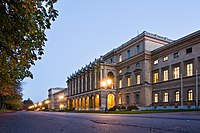 | |
| 42 | Royal Palace of Amsterdam | Amsterdam | 22,031 square metres (237,140 sq ft) | The palace was built as a city hall during the Dutch Golden Age in the 17th century. The building became the royal palace of King Louis Napoleon and later of the Dutch Royal House. It is often considered as the Eighth Wonder of the World. |  | ||
| 43 | Jelgava palace | Jelgava | 21,000 square metres (226,042 sq ft) | the Jelgava palace was being constructed from 1738-1772 in Mitau (modern day Jelgava), Latvia with it never being fully completed. It was built for the dukes of Courland but after the annexation of the country by the Russian empire, it became the residence of the governors of Courland. After being destroyed in World war 2 its interior was gutted and it became The University of Life Sciences and Technologies. Though attempts are being made in co-operation with Rundāle palace to restore a few rooms. |  | ||
| 44 | Rashtrapati Bhavan | Delhi | 215,300 square feet (20,000 m2) | The official presidential palace of the Republic of India. Originally constructed for the British Governor-General of India. | [62] |  | |
| 45 | Ras El Tin Palace | Alexandria | 17,000 square metres (182,986 sq ft) | Construction began in 1834, taking eleven years to complete the original design in 1845. Complementary work and the construction of additional wings continued for two more years until 1847, when it was officially inaugurated by Muhammed Ali of Egypt. |  |
References
- ^ a b Largest administrative building. Retrieved 29 April 2015.
- ^ "Palacio Real". Cyberspain.com. Retrieved 30 November 2012.
- ^ "Historic Ensemble of the Potala Palace".
- ^ "Structure of Potala Palace".
- ^ "Visit to Prague Castle". hrad.cz. Retrieved 9 February 2015.
- ^ "PALACE OF THE PARLIAMENT". cdep.ro. Retrieved 9 February 2015.
- ^ "Location of Parliaments in the later middle ages - UK Parliament". parliament.uk. Archived from the original on 11 May 2015. Retrieved 3 March 2017.
- ^ a b "Çèìíèé äâîðåö". spb-rf.ru. Retrieved 9 February 2015.
- ^ a b Royal Palace of Madrid statistics verified by official website, See also Palacio Real (Cyberspain)
- ^ "Palace | Definition of Palace by Merriam-Webster". merriam-webster.com. Retrieved 3 March 2017.
- ^ "Largest palace". Guinness World Records. Archived from the original on 12 May 2018. Retrieved 13 October 2016.
- ^ a b Bartholomew, James. The Richest Man in the World, Penguin Books Ltd; New Ed edition (February 22, 1990). ISBN 0-14-010890-4, ISBN 978-0-14-010890-3
- ^ "Largest residential palace". Guinness World Records. Retrieved 13 October 2016.
- ^ Belozerskaya, M.; Lapatin, K.D.S. (2004). Ancient Greece: Art, Architecture, and History. J. Paul Getty Museum. p. 12. ISBN 9780892366958. Retrieved 3 March 2017.
- ^ "Ancient Egypt Online".
- ^ MacDonald, W.L.; Pinto, J.A. (1995). Hadrian's Villa and Its Legacy. Yale University Press. ISBN 9780300068511. Retrieved 3 March 2017.
- ^ Watkin, D. (2005). A History of Western Architecture. Laurence King Publishing. p. 74. ISBN 9781856694599. Retrieved 3 March 2017.
- ^ Balmer, J.; Swisher, M.T. (2012). Diagramming the Big Idea: Methods for Architectural Composition. Taylor & Francis. p. 139. ISBN 9781136245459. Retrieved 3 March 2017.
- ^ Rodgers, N.; Dodge, H. (2007). Life in Ancient Rome: people and places : an illustrated reference to the art, architecture, religion, society and culture of the Roman world with over 450 pictures, maps and artworks. Hermes House. ISBN 9781844777457. Retrieved 3 March 2017.
- ^ "Saving the Golden House - Archaeology Magazine". archaeology.org. Retrieved 3 March 2017.
- ^ Spilsbury, Louise (2019). Ancient China. p. 20. ISBN 9781515725596.
- ^ a b Largest administrative building. Retrieved 22 December 2014.
- ^ a b "Palatul Parlamentului, o emblema a Bucurestiului « Hotel-Bucuresti.com Hotel-Bucuresti.com". Hotel-Bucuresti.com.
- ^ Douer, A.; Haupt, H. (1998). Wien, Heldenplatz: Mythen und Massen 1848-1998. Mandelbaum. ISBN 9783854760160. Retrieved 3 March 2017.
- ^ "A brief history - Hofburg | Wien | Österreich". hofburg-wien.at. Retrieved 3 March 2017.
- ^ Paris Convention and Visitors Bureau. "Musée du Louvre". en.parisinfo.com. Retrieved 9 February 2015.
- ^ "Presidential blow out: $600 mill palace". news.com.au. Retrieved 3 March 2017.
- ^ "www.msn.com/en-ae/news/world/pope-becomes-first-house-guest-in-controversial-erdogan-palace/ar-BBg6JdL". msn.com. Retrieved 3 March 2017.
- ^ http://translate.google.it/translate?sl=it&tl=en&js=n&prev=_t&hl=it&ie=UTF-8&layout=2&eotf=1&u=http%3A%2F%2Favirel.unitus.it%2Fbd%2Fautori%2Fcallari%2Fpalazzi_roma%2Fpalazzi_monumentali.html See the voice Vatican Palace
- ^ "unescoworldheritagesites.com". Retrieved 9 February 2015.
- ^ a b "10 Largest Castles in the World (with Photos & Map) - Touropia". touropia.com. Retrieved 3 March 2017.
- ^ "Il sito ufficiale della Presidenza della Repubblica | official Italian Republic's Presidency website". quirinale.it. Retrieved 3 March 2017.
- ^ "Il Quirinale, la residenza più vasta del mondo". loveforitaly.it. Retrieved 18 July 2013.
- ^ "Pembinaan Istana Negara, Jalan Duta". malay.wiki. Retrieved 2021-02-10.
- ^ "ISTANA NEGARA, KUALA LUMPUR". pengurusan.istananegara.gov.my. Retrieved 2021-02-10.
- ^ "See reference on official British monarchy website". royal.gov.uk. Archived from the original on 14 January 2015. Retrieved 9 February 2015.
- ^ "Royal Residences: Buckingham Palace | The Royal Family". royal.uk. Retrieved 3 March 2017.
- ^ "Guinness Book of Records entry on Pražský hrad". Archived from the original on 21 July 2006. Retrieved 3 March 2017.CS1 maint: bot: original URL status unknown (link)
- ^ "Topkapi Palace". MyDestination.com Istanbul Travel. Retrieved 9 February 2015.
- ^ "best-of-istanbul.com". Retrieved 9 February 2015.
- ^ Welcome to Versailles
- ^ [1]
- ^ "Lov om Dronning Margrethe den Andens civilliste" [Act on Queen Margrethe the Second's civil list] (in Danish). Retsinformation.dk. Retrieved 6 May 2011.
- ^ "kongehuset.dk/english/palaces/christiansborg-palace/christiansborg-palace". kongehuset.dk. Retrieved 3 March 2017.
- ^ "Christiansborg Slot - Slotte og haver - Kongelige Slotte". christiansborg.dk. Retrieved 3 March 2017.
- ^ "Archived copy". Retrieved 3 May 2016.
- ^ "www.hrp.org.uk/hampton-court". hrp.org.uk. Retrieved 3 March 2017.
- ^ "Royal Palace of Brussels | The Belgian Monarchy". monarchie.be. Retrieved 3 March 2017.
- ^ "Guida artistica di Firenze". mega.it. Retrieved 3 March 2017.
- ^ "Elevation of Frederiksborg Castle 3400 Hillerod with altitude and height". elevationmap.net. Retrieved 3 March 2017.
- ^ "www.slke.dk/slotte/frederiksborg-slot/tal-og-fakta/". slke.dk. Retrieved 3 March 2017.
- ^ "Schönbrunn". schoenbrunn.at. Retrieved 3 March 2017.
- ^ "Panorama train – Tiergarten Schönbrunn". zoovienna.at. Retrieved 3 March 2017.
- ^ "Cercedilla dreaming - Urban Walking in Spain - easy hiker". easyhiker.co.uk. Retrieved 9 February 2015.
- ^ UNESCO World Heritage Centre. "Kronborg Castle - UNESCO World Heritage Centre". whc.unesco.org. Retrieved 3 March 2017.
- ^ "Elevation of Kronborg Kronborg 2c 3000 Helsingor with altitude and height". elevationmap.net. Retrieved 3 March 2017.
- ^ "Kronborg Slot - Slotte og haver - Kongelige Slotte". kronborg.dk. Retrieved 3 March 2017.
- ^ "Elevation of Amalienborg Amalienborg Slotsplads 5 1257 Kobenhavn K with altitude and height". elevationmap.net. Retrieved 3 March 2017.
- ^ "www.slke.dk/slotte/amalienborg/tal-og-fakta/". slke.dk. Retrieved 3 March 2017.
- ^ "Ì.Ì. Ïîñîõèí: Ðåêîíñòðóêöèÿ è ðåñòàâðàöèÿ Áîëüøîãî Êðåìëåâñêîãî Äâîðöà". posokhin.ru. Retrieved 9 February 2015.
- ^ "Residenz München". Bayerische Schlösserverwaltung.
- ^ "overview-of-rashtrapati-bhavan". presidentofindia.nic.in. Retrieved 3 March 2017.
- Palaces
- Lists of largest buildings and structures
- History-related lists of superlatives